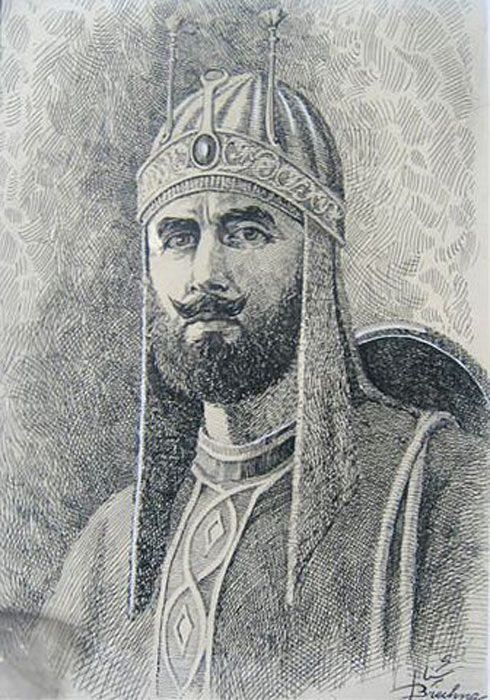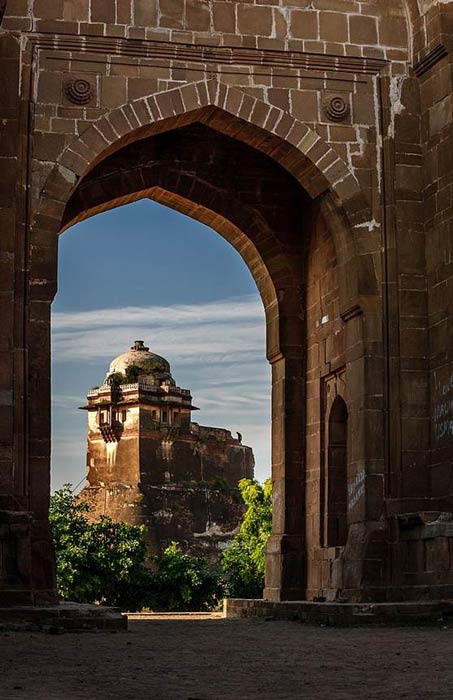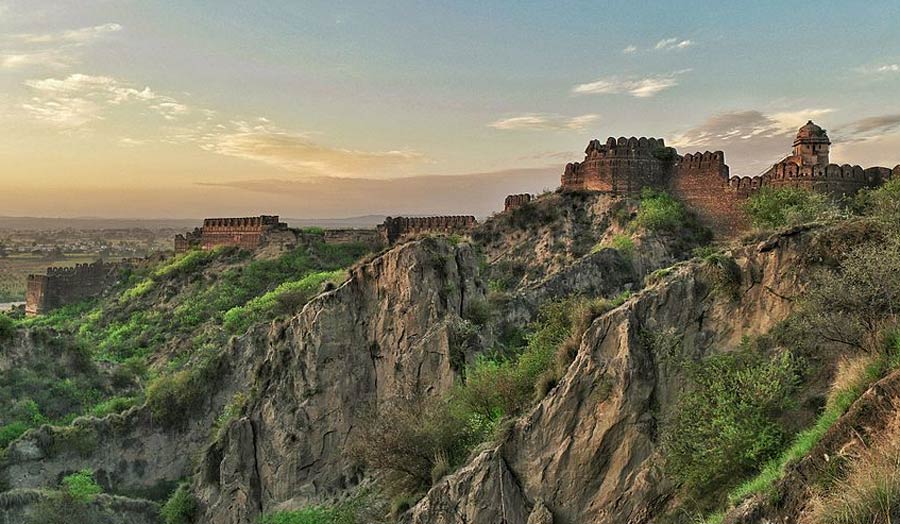The Perfect Castle? The Indestructible and Unconquered Rohtas Fort
Rohtas Fort located in Punjab, one of Pakistan’s four provinces. The construction of the fort was ordered by Sher Shah Suri, the founder of the Indian Suri Empire, though the actual work was carried out by one of his subordinates, Todar Mal. When Rohtas Fort was built in the 16th century it was meant to serve two main purposes. The first was to block Humayun, the Mughal emperor, from returning to India. The second was to suppress the local Pakistani Gakhar tribes, who refused to submit to Sher Shah Suri. Rohtas Fort is considered as one of the most formidable forts on the Indian subcontinent and is reputed to have never been taken by storm. In time, the military function of the fort diminished, and it was used mostly as an administrative center. Rohtas Fort has survived remarkably intact and was inscribed as a UNESCO World Heritage Site in 1997.
Rohtas Fort, known also as Qila Rohtas in Punjabi and Urdu, is situated near Jhelum, a city on the east bank of the Jhelum River. It should be noted that the Rohtas Fort of this article should not be confused with another Rohtas Fort, known also as Rohtasgarh. The latter is located in the Son River valley, in Rohtas, a small town in Bihar, India. Although the two forts have no connection with one another, they are linked by a common historical figure: Sher Shah Suri.

Imagined sketch of Sher Shah Suri founder of the Indian Suri Empire, who initially envisioned Rohtas Fort, by Afghan artist Abdul Ghafoor Breshna. (Ustad Abdul Ghafur Breshna / Public domain)
How Rohtas Fort Came To Be And Why
Whilst Sher Shah Suri was responsible for the construction of Qila Rohtas, he used a ruse to capture Rohtasgarh. Sher Shah Suri captured the fort in 1539, after losing Chunar Fort to Humayun, the Mughal emperor. Desperate for a new stronghold in the area, Sher Shah Suri approached Hari Krishnan Rai, the ruler of Rohtas, requesting Rai’s permission to leave his women, children, and treasure in the safety of the fort. Hari Krishnan Rai agreed to Sher Shah Suri’s request, and the latter brought his palanquins to the fort. Whilst the first few palanquins were indeed transporting women and children, the rest had soldiers hidden in them. Through this ruse, Sher Shah Suri captured Rohtasgarh.
Although Shah Sher Suri had been defeated by Humayun on this particular occasion, the Mughals were ultimately defeated in 1540 at the Battle of Kannauj. Following this defeat, Humayun fled westwards, where he was forced to live in exile for the next 15 years of his life. Shah Sher Suri had initially been in the service of the Mughal Empire, before turning against his overlords, defeating them, and establishing his own empire, the Suri Empire.
- Humayun's Tomb, the Mughal Mausoleum That Changed India’s Architecture
- Going Where Archaeologists Cannot, Spy Satellites Reveal Thousands of Forgotten Ancient Sites in Afghanistan
Shah Sher Suri is thought to have been born around 1486 in Sasaram, a city in Bihar. Sher Shah Suri was a Pashtun, specifically the Sur tribe (hence the surname Suri), and his ancestors were from Afghanistan. Shah Sher Suri was known originally as Farid Khan, and was one of eight sons of Hasan Khan, a horse breeder. As a youth, Shah Sher Suri left home against the wishes of his father, and entered the service of Jamal Khan, the governor of Jaunpur. Shah Sher Suri then went on to serve the Mughal governor of Bihar, rising through the ranks, and finally seized Bihar for himself. In 1538, Shah Sher Suri founded the Suri Empire.
Shah Sher Suri also defeated the ruler of Bengal in battle, but was not able to capture the kingdom, as Humayun suddenly launched a campaign against him. Nevertheless, Shah Sher Suri defeated the Mughal emperor at the Battle of Chausa in 1539, and again at the Battle of Kannauj in 1540 AD. As mentioned earlier, Humayun was forced into exile after the Battle of Kannauj. Nevertheless, the Mughal emperor was still considered a threat by Shah Sher Suri.
Therefore, the Suri emperor decide to build Rohtas Fort as a means of preventing Humayun from returning to India. Apart from that, Rohtas Fort was also constructed to suppress the Gakhars who dominated the Pakistani Potohar Plateau. These were allies of Humayun who refused to submit to Shah Sher Suri.

The Kabuli Gate of the Rohtas Fort complex in present-day Pakistan. (Meemjee / CC BY-SA 3.0)
Rohtas Fort Constructed by Suri Empire Official Todar Mal
The task of building Rohtas Fort fell upon the shoulders of Todar Mal, an official of the Suri Empire. Todar Mal faced problems from the very start of the project. As mentioned earlier, the Gakhars refused to submit to Shah Sher Suri. Therefore, although the fort was being built on their land, they refused to provide labor for the undertaking. Todar Mal reported this problem to his master, who supposedly replied as follows,
“I know you for a man of business, understanding and intelligence. I see no work can be expected from you, because you consider money as your friend. When I have commanded you to do a thing you ought not to have cared for money in fixing the rate. Whatever be the expenses, shall be borne by my government.”
With the financial backing of Shah Sher Suri, Todar Mal was able to entice some of the Gakhars to provide the labor required to build the fort. This, however, made Rohtas Fort a very costly project. The willingness of Shah Sher Suri to spend such a huge sum of money on the fort indicates the importance placed by the Suri emperor on this fortification.
Shah Sher Suri, however, died in 1545, before the fort was completed. Additionally, the empire that he founded lasted only about 10 years after his untimely death. Furthermore, in 1555, Shah Sher Suri’s nemesis, Humayun, returned to India, and restored the Mughal Empire. The biggest irony, however, is that when Humayun returned Rohtas Fort was given to the Gakhars, who made it their capital.
Indeed, what happened to Rohtas Fort after Shah Sher Suri’s death shows that it ultimately did not fulfil its purpose. In addition, now that the area was under Mughal rule, and that the Gakhars were their allies, the defensive function of the fort was no longer significant. All the same, Rohtas Fort was a monumental structure.

The extremely thick protective walls of Rohtas Fort made it hard to overcome for centuries. (Meemjee / CC BY-SA 3.0)
The Main Structures and Buildings of Rohtas Fort
The plan of the fort is irregular, as it followed the contours of its hilltop site. Nevertheless, the plan roughly resembles a triangle. The fortifications of Rohtas Fort consist of 4 kilometers (2.5 miles) of walls. The thickness of the walls varies from one area to another. This is true as well for their height. The thickest walls are found near the Mori Gate, on the northern perimeter. The walls here reach a thickness of 12.5 meters (41 feet). The height of the walls ranges from 10 to 18.3 meters (32.9 to 60 feet).
- The Navratnas: Nine Jewels of Emperor Akbar’s Mughal Court
- Shah Jahan: Mughal Emperor, Creator of the Taj Mahal, Champion of Fine Cuisine

Tower of Rohtas fortress in Punjab Pakistan. (homocosmicos / Adobe Stock)
For the most part, the walls were made of coarse sandstone rubble masonry. This was held together by a mortar made of lime mixed with granular brick powder. The gates, however, were built of ashlar masonry, which is much stronger. Along the walls are as many as 68 bastions, as well as about a dozen major gates that provide entry to the fort. Additionally, vaulted chambers are found in various areas along the wall. These were meant to serve as storage for the supplies needed by the fort’s garrison. It is claimed that Rohtas Fort was able to house as many as 30,000 soldiers at any one time.
The fort’s citadel is situated in its northwestern corner. This area is separated from the rest of the fort by a 0.53 kilometer (0.33 mile) long wall. This is the most heavily fortified part of the fort. It is also in the citadel that several of the fort’s remaining architectural monuments can be found.
One of these is the Shahi Mosque. This is a small mosque with a prayer chamber and a small courtyard. It is located near the Kabuli Gate, and a flight of stairs leads directly from the courtyard to the gate. The mosque was also used in the event of an attack. The Shahi Mosque is the most decorated of the fort’s original buildings. Nevertheless, the building served a defensive function as well, as its outer wall was built into the fort’s outer wall.

The Raja Man Singh haveli at Rohtas Fort. (Shahbaz Aslam6669 / CC BY-SA 4.0)
Rohtas Fort’s Haveli Man Singh, and Other Key Buildings
Another significant structure at the fort’s citadel is the Haveli Man Singh. This is a two-story building constructed from brick and plaster. Unlike much of the rest of Rohtas Fort, the Haveli Man Singh was not built by Todar Mal. Instead, it was built sometime between 1550 and 1614, by Raja Man Singh I of Amber, a renowned general of the Mughal emperor Akbar. The architecture of the Haveli Man Singh, which is Hindu in style, stands in stark contrast to the rest of the Rohtas Fort, which was built in an Afghan architectural style. The Haveli Man Singh was built on the highest spot of the fort. Originally, the Haveli Man Singh had four rooms. As time went by, part of the structure collapsed, and only one room remains today.
Not far from the Haveli Man Singh is the Rani Mahal (“Queen’s Palace”), which was also not built during the time of the Suri Empire. It is thought that this building was constructed in the Hindu architectural style around the same time as the Haveli Man Singh. The Rani Mahal has only one story, and like the Haveli Man Singh, it had originally four rooms. At present, however, only one room remains. This room is richly decorated both on its interior and exterior and is topped by a flower-shaped dome.
Apart from these structures, three baoli water wells can be seen at Rohtas Fort. These stepped water wells were created by cutting deep into the earth and lining the walls with stone. The main baoli is located in the middle of the fort and has 148 steps. It is thought that this baoli was used to provide water for the soldiers, elephants, and horses stationed in the fort. The Shahi baoli is located near the Kabuli Gate and has 60 steps. This baoli was used by the royal family. The third baoli, the Sar Gate baoli, is a small well near the Sar Gate, and probably provided water for the soldiers.

A panoramic view of Rohtas Fort today, which is a major UNESCO tourist attraction. (Skazimr / CC BY-SA 3.0)
Rohtas Fort Mughal Rule and Modern Tourism
For much of the period when Rohtas Fort was under Mughal rule, it was in the hands of the Gakhars. As these proved to be loyal allies of the Mughal, the fort lost its military function, and was used for administrative purposes instead. From time to time, the Mughal emperors would stop at the fort. For instance, Akbar is recorded to have stayed at the fort for a single night. Another emperor, Jahangir, visited the fort on two occasions. By the late Mughal period, however, Rohtas Fort seems to have been completely ignored by the emperors.
The Mughals eventually lost Rohtas Fort in 1825. By this time, the Mughal Empire was in decline. One of the consequences of the weakening of the Mughals was the founding of the Sikh Empire in 1799. Rohtas Fort was captured for the Sikh Empire by general Gurmukh Singh Lamba. At that time, the fort was held by the Ghakar chief Nur Khan. Maharaja Ranjit Singh, the Sikh ruler, placed the fort, along with a contingent of 700 horses under the command of Mohar Singh. Subsequently, these were placed under Gurmukh Singh Lamba’s command, after Mohar Singh’s retirement to Banaras.
- Mysterious Ancient Cross Found in Northern Pakistan
- Jahanara and Roshanara: Rival Princesses of the Mughal Empire
The last time Rohtas Fort was used for military purposes was during the rebellion of Sher Singh Attariwalla, who was joined by Raja Fazal Din Khan. During the rebellions, however, the fort did not see any action. The Sikhs retained control of Rohtas Fort until 1849, when their empire was dissolved by the British.
Rohtas Fort has been turned into a tourist attraction in modern times, and in 1997, was inscribed as a UNESCO World Heritage Site. The fort is able to boast of its excellent state of preservation. Nevertheless, heavy rains, the seepage of rainwater, and erosion in recent times have caused some damage to some of the fort’s gates.
In 2000, the Rohtas Fort Conservation Program was initiated by the Himalayan Wildlife Foundation. Some of the projects carried out by the program over the years, in conjunction with the Royal Norwegian Embassy, include the conservation of the Talaqi and Gatali Gates, which were damaged by heavy rains, and the establishment of a museum in the upper story of the Sohail Gate.
Top image: A view of Rohtas Fort, which is located on the outskirts of Jhelum, Pakistan. Source: Hussain Khalid / CC BY-SA 4.0
By Wu Mingren
References
Asian Historical Architecture, 2022. Rohtas Fort, Jhelum, Pakistan. Available at: https://www.orientalarchitecture.com/sid/889/pakistan/jhelum/rohtas-fort
District Government Jhelum, 2017. Rohtas Fort. Available at: https://jhelum.punjab.gov.pk/rohtas_fort_pp
Fatima, S., 2020. History of Rohtasgarh Fort – Bihar. Available at: http://www.heritagetimes.in/rohtasgarh-fort-bihar/
New World Encyclopedia, 2019. Rohtas Fort. Available at: https://www.newworldencyclopedia.org/entry/Rohtas_Fort
The Editors of Encyclopaedia Britannica, 2021. Shēr Shah of Sūr. Available at: https://www.britannica.com/biography/Sher-Shah-of-Sur
UNESCO, 2022. Rohtas Fort. Available at: https://whc.unesco.org/en/list/586/
World Archaeology, 2006. Pakistan: Rohtas Fort. Available at: https://www.world-archaeology.com/features/pakistan-rohtas-fort/



















